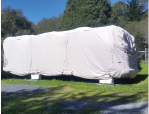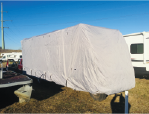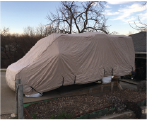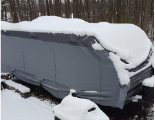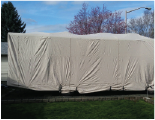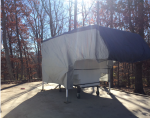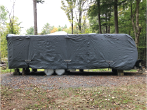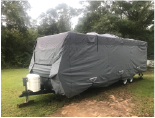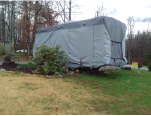
RV COVER FAQ'S
Why do I need to cover my RV?
As long as you have chosen a great quality RV cover that is waterproof, UV resistant, and made from durable material, you will be very happy you have it to protect your RV from damage. An RV coverreduces your workload as an RV owner by protecting the RV from the things that damage it, like bird droppings, water, falling foliage, and more. When you have an RV cover, you can just uncover and go, instead of standing on the roof of your RV sweeping off leaves and scraping off bird droppings.
Many RVs have rubber roofs that are more susceptible to UV damage, causing it to crack or fade. A UV resistant RV cover will ensure that your RV stays in mint condition while it is not in use.
Are RV covers waterproof?
Beware! Not all RV Covers are waterproof. They may say they are water resistant, but when water pools on the cover, it will begin to seep through.
Make sure that the RV cover you choose is made from the best material. The Goldline RV cover is made from heavy-duty fabric that has a Sof-Tec coating, which means it is 100% waterproof. In addition, the Goldline covers are treated with a UV inhibitor for maximum protection from sun damage.
Which RV cover is best?
Important things to look for in an RV cover are:
- Waterproof
- UV resistant
- Custom-like fit
- Easy installation
- Breathability
How do I clean my RV cover?
Use a sponge to spot clean with mild soap and water. Do not use an abrasive cleaner or brush.
What is the cost of an RV cover?
There is a big range in cost for RV covers, depending on the quality of the cover, whether it is a custom or semi-custom fit, and the size of the rig you are covering. Costs ranges anywhere from $50 to $1,200.
How do I know my RV cover will fit?
National RV Covers come in two-inch incremental sizes to fit specific RVs, so as long as you have measured your rig properly, there will be a cover that will fit it snugly.
How do I install an RV cover?
- Cover or tape any sharp edges on your RV that could wear against your cover. Be sure to lower any roof antennas.
- Unroll the cover next to your trailer. Unzip the passenger side and back panels.
- On smaller RVs, your cover can be installed with ladders or by pulling it over the sides with tie ropes (be sure not to snag the cover on the top). On larger RVs, it’s easier to install your cover from the roof. Carefully climb up on top of the roof pulling the cover up with you. Lower the front of your cover down over the front of the RV then move to the back pulling the cover and letting the cover fall down the sides. Some covers may come with a ladder cap to reduce stress on the cover in that spot. If a ladder cap was included, please place it over the ladder first. Then pull the cover down over the back of the RV.
- Zip all the panels closed on your RV cover then pull the elasticized corners down over both bumpers of your RV.
- Adjust the tension straps in front of your cover for a snug fit. Do not overtighten.
Do I need to cover the wheels of my RV also?
Tire covers are highly recommended if you are storing your rig most of the time. Tire temperatures can reach over a hundred degrees Fahrenheit, which can cause tires to crack. You don’t want to have to replace an entire set of RV tires, because that would be very expensive.
How long will my RV cover last?
A good quality RV cover that has been handled and stored properly should last indefinitely.

.png)
